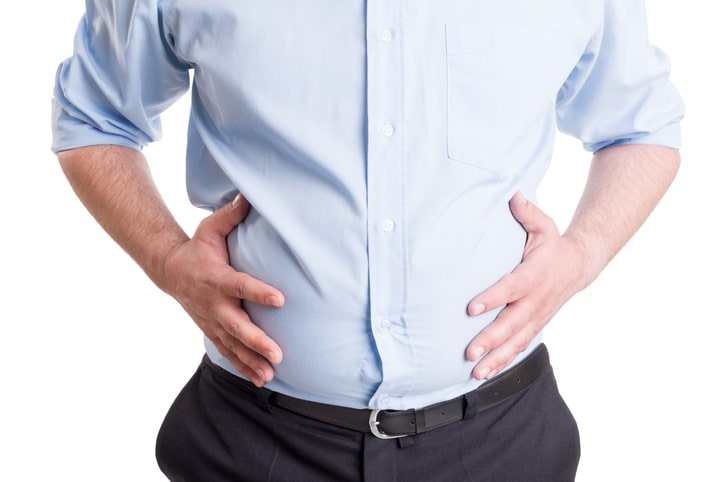If you’re carrying extra weight, it’s better to have “love handles” than a “spare tire.”
That’s the take-home message of a new study that shows belly fat is worse for your heart than flab elsewhere.1 A lot worse.
Researchers collected data on 1,106 men and women whose average age was 45. Scientists measured subcutaneous adipose fat. This is fat just under the skin. It is often on the sides. Some people refer to it as love handles.
They also measured visceral adipose fat. This is fat inside the abdominal cavity. It results in a pot belly, often called a “spare tire.”2
Over a six-year period, participants agreed to allow detailed measurements of their health markers. They had CT scans to measure their fat distribution along with regular tests for cholesterol, blood sugar, triglycerides, and blood pressure.
Recommended for You: Pain in Your Prostate? Try the Secret Cherokee Pain Remedy
The Cherokee used this sacred plant to relieve their daily aches and pains. And recently, an elite group of California researchers discovered a way to perfect it for pain relief—by lowering your levels of PGE-2, the chemical that causes swelling and discomfort.
Better yet: it works in as little as 30 minutes. If you feel like you have to go all the time, but blocked, and uncomfortable…this could be your secret relief. Go HERE for all the details.
Like most people, as the study subjects got older, they put on weight. Some added more subcutaneous fat (love handles) and others more visceral fat (belly fat).3
People who added belly fat had much greater increases in markers for heart disease and stroke than those who added subcutaneous fat. They had higher blood pressure, blood sugar, and triglycerides. And they had lower levels of HDL (“good”) cholesterol.
Dr. Caroline Fox is a former senior investigator for the National Heart Lung and Blood Institute. She was the study’s senior researcher. Dr. Fox said that subcutaneous fat just under the skin may actually be protective. It serves as a “metabolic sink for storing excess fat particles” in a place where it less harmful, she said.
Belly fat, on the other hand, fills the spaces between organs…where it impairs organ function and causes metabolic syndrome.
The study shows that just a little visceral (belly) fat is more dangerous than a lot of subcutaneous fat, Dr. Fox said. The study was published recently in the Journal of the American College of Cardiology.4
4 Ways to Get Rid of Belly Fat
Simple lifestyle changes can help you reduce belly fat and improve your heart health:
- Follow the 30-minute rule. Get 30 minutes of exercise every day. Even something as easy as walking can stop or even reverse visceral fat gain.5
- Eat more complex carbs. The sugars in fruits and vegetables take longer to digest than carbs from other foods. This means they don’t cause spikes in blood sugar, which can lead to belly fat. Dump all processed foods with added sugar and eat more fruits and vegetables.
- Strength training. Contrary to popular belief, ab workouts don’t burn belly fat more than other strength exercises. Adding muscle anywhere helps your body reduce stored fat. Resistance exercise is shown to increase something called post-exercise fat oxidation. This is another way of saying that it increases the amount of stored fat you burn after exercise. The effect can last for more than a day after a strength workout.6
- Get more vitamin D3 and calcium. As INH revealed earlier, a study published in the American Journal of Clinical Nutrition found that adding 350 mg of calcium and 100 IUs of vitamin D to your diet each day significantly decreases stomach fat. Vitamin D3 and calcium work synergistically—increasing the breakdown of stored fat. It’s fine to take D3 supplements, but get your calcium naturally in the foods you eat. Calcium supplements are linked to heart problems. Healthy high-calcium foods include leafy greens, sardines, broccoli, and almonds.7,8
If you’re trying to lose belly fat, there’s something else you should know… There’s a secret “switch” that tells your body to burn fat instead of store it. Discover how to unlock your fat-burning potential HERE.
In Good Health,

Angela Salerno
Executive Director, INH Health Watch
Like this Article? Forward this article here or Share on Facebook.
References:
1https://consumer.healthday.com/vitamins-and-nutrition-information-27/body-fat-health-news-300/spare-tire-worse-for-heart-than-love-handles-eart-disease-study-715210.html
2https://www.sciencedaily.com/releases/2016/09/160926142822.htm
3https://www.sciencedaily.com/releases/2016/09/160926142822.htm
4https://www.acc.org/about-acc/press-releases/2016/09/26/15/13/study-shows-more-reasons-why-belly-fat-is-dangerous-for-the-heart?w_nav=S
5http://askdrnandi.com/spare-tire-love-handles-worse-heart/
6http://muscleevo.net/best-way-to-lose-belly-fat/
7https://www.institutefornaturalhealing.com/2012/07/these-two-nutrients-work-in-synergy-to-bust-belly-fat/
8https://draxe.com/top-10-calcium-rich-foods/

